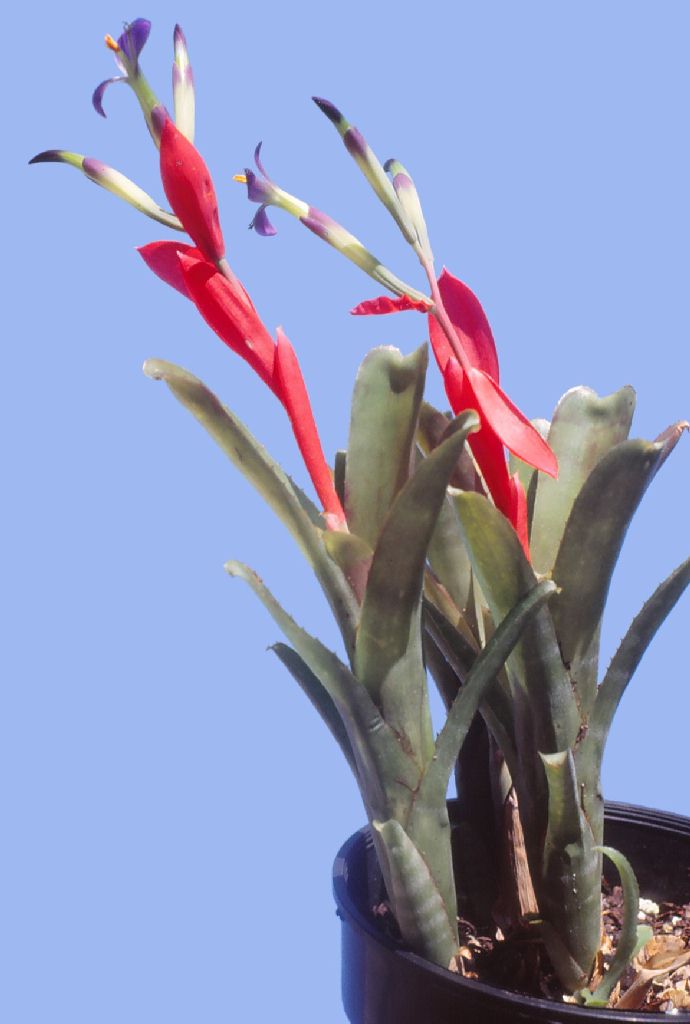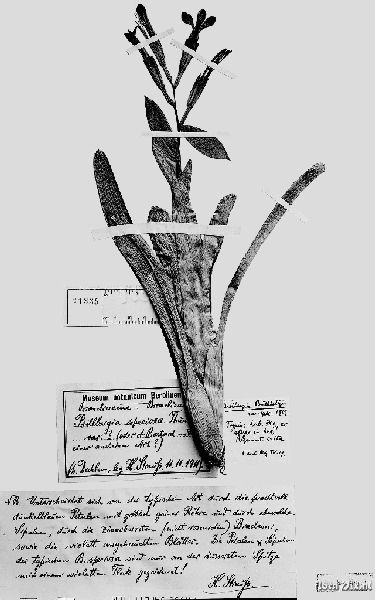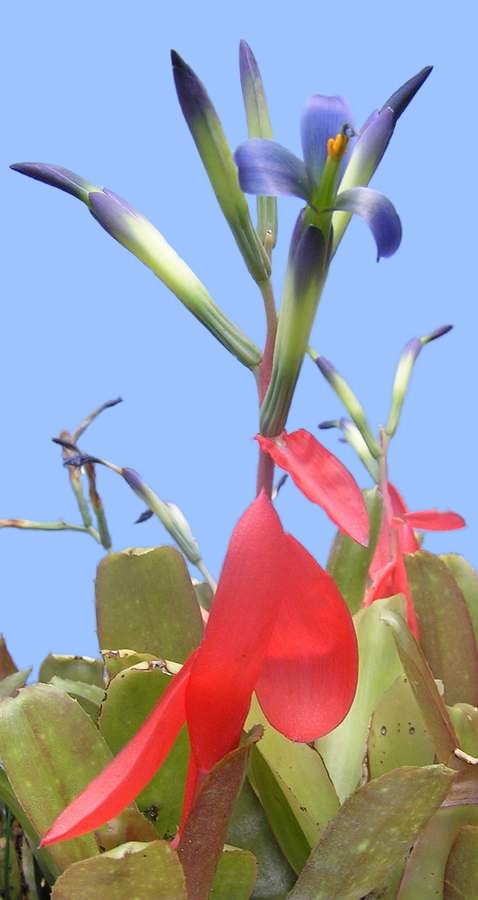
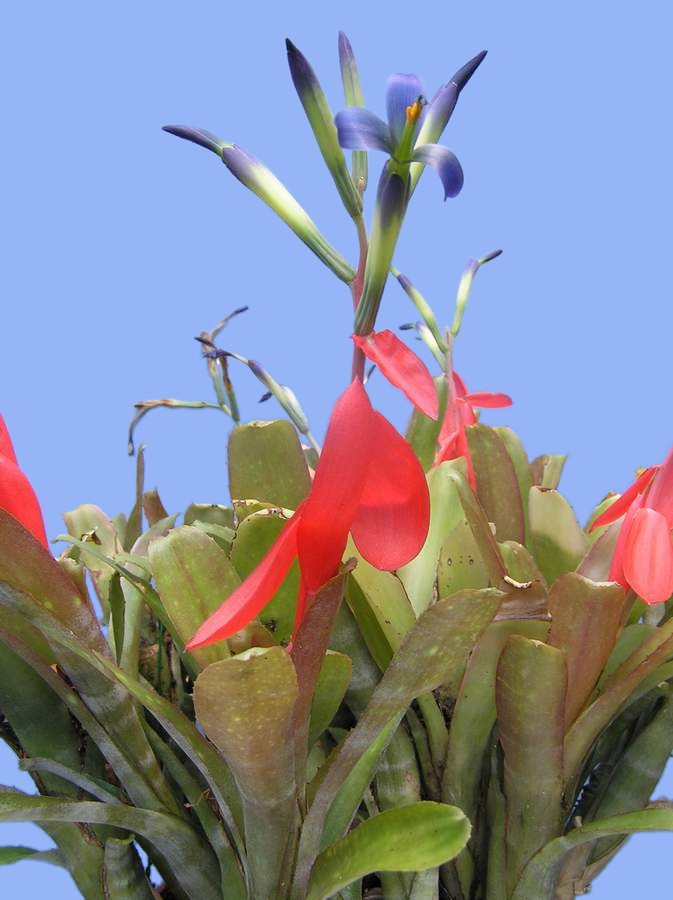
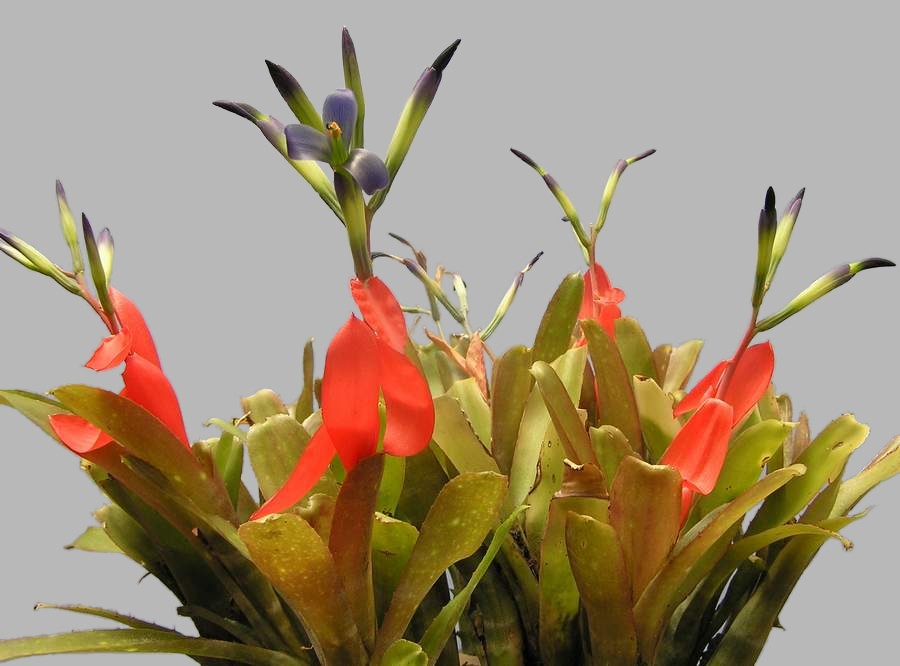
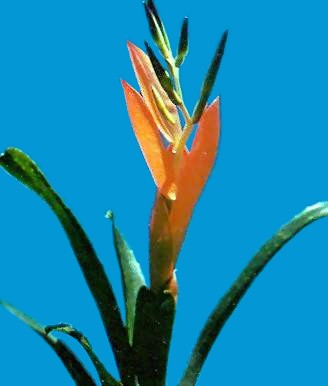


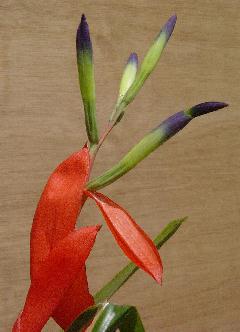
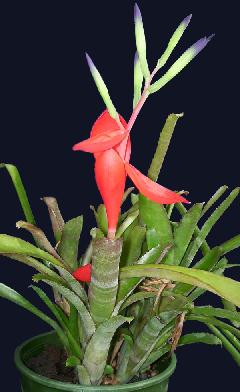
In 1977 in the Journal of the Bromeliad Society page 121, Victoria Padilla had a photograph which had this caption “ A hybrid of the old European cross known as B. ‘Wendii’” In my investigation of Billbergia ‘Windii’ and ‘Theodore L Mead’ (which I proved to my own satisfaction are identical) this photograph was brought into the equation! But it looks nothing like Billbergia ‘Windii’ and perhaps the caption should have said “An unnamed hybrid from the old European cross B. ‘Windii’ “. In any event this too is misleading because in my experience all hybrids with B. ‘Windii’ in their makeup show the traits of the ubiquitous B. nutans! This trait is not apparent from the photograph."
Anyway, this plant is a ‘dead ringer’ for our little hybrid. It clearly has links with Billbergia amoena in its many forms and has even been misidentified with Billbergia nana. So if you do have a plant called Billbergia nana I would suggest you check its credentials.
Our plant can be described as having a tight tube of leaves to 20cm high where the leaves are only 3cm wide, green with a few white spots and barring, and sometimes with a pinkish hue. The erect scape exceeds the leaf tube and the 3-4 large, red scape bracts hold their colour for some time. The inflorescence has only 4-5 flowers which are green but tipped with bright blue on both the sepals and petals. If you want to see these in colour then try http://fcbs.org on the internet.
So, the plant we knew as ‘Windigig x speciosa’ is now named ‘Windigig Special’
As you know, Cultivars can only be listed by name and not by formula which is the reason for this slight change in name. If, by any chance, you do know any more history about this mystery please let me know.
Yes, plant labels or lack of them can be fun but also frustrating as Harold Barons pointed out at the April 2004 meeting of the Bromeliad Society of Australia Inc. What is best? No label or a wrong label? Bill Treloar over here in South Australia prefers no label because he picks the plant from the raffle prizes by its looks and not its label. He then spends time asking around for various opinions which he notes until he has what he considers is probably correct. He then asks me or Margaret and we give him further ideas and a chance to look at photos to decide for himself. Any of you who has access to the Internet can do this for themselves via fcbs.org!
Reading newsletters like Bromeletter also makes you aware of what plants are circulating around Oz under different names. Some even help you solve a problem and this is the situation here. Photographs do help even black and white ones.
We read that Ruby Ryde bought a plant from the bargain stalls in San Francisco in 2000 and she got a bargain she was not expecting. It had Billbergia buchholtzii on the label and this name had probably followed each offset since 1961. Why 1961? Keep reading! The only problem I think is that it had lost the No.1 which would have properly identified it!
Let us read what J A Giridlian said in Brom Soc Bull.11(1)12.1961
“After Mr. Atkinson's death these plants were widely distributed by Evans & Reeves Nursery of Los Angeles under the name of B. enderi hybrids, enderi being a synonym for B. amoena which now has been identified as B. buchholtzi. Since I have three very distinct plants all of which have been identified with the same name, I call this one B. buchholtzi No1. This particular plant is a low growing, slender plant with a very brilliant orange-red bract. It has been used many times in crossing with other species to impart this bright orange coloring to its progeny, which indeed it does. These characteristics are shown in the hybrid plant under discussion because it is lower growing than any B. vittata I have ever seen, and the color of the bract is bright warm red, a color I have never encountered in the true B. vittata, no matter how variable. Also, along with other hybrid Billbergias, it has the habit of bloom¬ing more than once a year.”
Then in 1962 Brom. Soc. Bull.12(3):46. Mulford Foster wrote
“B. buchholtzii - This plant does not appear in any listings of commercial growers, but Oakhurst Gardens in southern California has for sale three variations. Whether these belong under the listing of B. buchholtzii is not known. However, the plants so named are very attractive. No. 1 is a dwarf form with brilliant orange-scarlet bracts and deep blue flowers. When well established, it will have several blooming periods a year. No.2 has tall, light green foliage, rose bracts and lavender flowers. No.3 has very attractive leaves of huge size, deep green with bronze shadings and barred transversely with gray. It becomes purplish in the sun. The flowers are violet with pink bracts.”
How can you possibly have 3 sorts of plants with the same name? Intriguing but not impossible 42 years ago. There is a description of Billbergia buchholtzii in Smith & Downs on page 1983/4. This plant was originally described by Mez in Repert. Sp. Nov. 16: 7. 1919. for a plant from the Berlin Botanical Garden.
Two completely different looking plants each called Billbergia buchholtzii were displayed at the World Conference in San Francisco in 2000 and Ruby must have missed them. I saw the photographs taken by Mike Andreas which meant I just had to investigate. Thanks to Rodney Kline of California and lots of questions asked of old members it was revealed that the true Billbergia buchholtzii was owned by a Tom Koerber who has been well known in Bromeliad circles for many years. Please don’t ask me how the other plant at the Show got named!! This Billbergia buchholtzii has links with the No3 mentioned above AND is very close to the Mez description. Incidently, the inflorescence just peeks out of the leaf tube otherwise you would say it was our ‘Chas Webb’ which you may recall was a name given by Olwen Ferris for a plant that had been growing in Australia well before the Brom. Society of Australian was formed. If you come across a ‘Chas Webb’ where the inflorescence does NOT stick out, just think about Billbergia buchholtzii !!
Back to Billbergia buchholtzii No.1. which is only a small fellow. Older members must remember Billbergia ‘Windigig x speciosa’. It has a mention in the early Bromeletters in 1960. In 1977 Victoria Padilla featured it as a hybrid of ‘Wendii’ (sic) on page 121 in the Jour. Brom. Soc. Just have a look at this coloured photo. In 1990 I was visiting Bill Morris up Newcastle way and saw his Billbergia nana which I said looked awfully like my Billbergia ‘windigig x speciosa’. He said that he had changed the name because he considered it was the same as the photo in Journ. Brom Soc. 39:18. 1989 of Billbergia nana. I pointed out I did not follow his reasoning in linking a hybrid with a species. Bill did not have access to the original description by Pereira in 1973 either! I now have this description, translated it from the Latin and Portuguese and consider Bill was too hasty. If anyone wants to check my conclusion I can send them the description. Bill sold his billbergias including the alleged Billbergia nana to Olive and I feel sure this is how Margaret Draddy got her plant with this name!
More recently I decided that Billbergia ‘Windigig x speciosa’ needed a proper cultivar name so it could be captured in the Bromeliad Cultivar Register and its official name is now Billbergia ‘Windigig Special’
The report of Ruby Ryde’s plant has completed the cycle for me in that this plant from California must be is in fact Billbergia buchholtzii No1 and should be given the name ‘Windigig Special’. This way we will only have one name to remember for the erroneous Billbergia nana and the erroneous B. buchholtzii. Would the owners of these plants please check the black and white photos attached and let me know, post haste, if my guessings without photographs is incorrect?
Eventually something like D.N.A. analysis may be able to sort out if the plant is a hybrid or a species and if it is simply another amoena.
Billbergia Windigig Special








Remember this is now treated as a hybrid as recognised by Carl Mez and not a species as recognised by Lyman Smith. It is recorded in the Bromeliad Cultivar Register http://botu07.bio.uu.nl/bcg/bcr/index.php?fields=&id=9647&search=buchh
Over the last 15 years I have written widely on the problems with this plant and if it does survive in captivity. It is very rare indeed that there are herbarium specimens in existence for alleged hybrids and even rarer that they survived the devastation in Berlin at the end of World War II. These survived so why should not living plants. It is only recently that access to herbarium material has been available in electronic form in selected herbaria and we are lucky that Berlin is one.
In 1911 a herbarium specimen was lodged at Berlin called Billbergia speciosa or a hybrid of it. In 1919 it was noted by Mez as being Billbergia buchholtzii. Here the problem starts because there is another specimen noted by Mez as also being Billbergia buchholtzii in 1917 and this was the one used to describe Billbergia buchholtzii Mez, Repert. Sp. Nov. 1.6: 7. 1919. The following comment was made;
“Habitat unknown, probably East - Brazil. - I obtained examples from three different gardens under three different incorrect names. It is unanimous that it is a garden-hybrid; it is named in honour of the Garden-inspector Buchholtz, my co-worker in the cultivation of Bromeliaceae.”
Does this include the herbarium specimen that was lodged in 1911? If so why was B. speciosa not mentioned!!
Let us now move to the 1950’s when we were growing a plant in Australia that looked like a small B. amoena but had the odd name of ‘Windigig speciosa’. Obviously it was a misspelling but from what? This was registered as ‘Windigig Special’. The reference to ‘speciosa’ could well link to the name on the 1911 herbarium specimen!
Let us now read what J A Giridlian said in Brom Soc Bull.11(1)12.1961
“After Mr. Atkinson's death these plants were widely distributed by Evans & Reeves Nursery of Los Angeles under the name of B. enderi hybrids, enderi being a synonym for B. amoena which now has been identified as B. buchholtzi. Since I have three very distinct plants all of which have been identified with the same name, I call this one B. buchholtzi No1. This particular plant is a low growing, slender plant with a very brilliant orange-red bract. It has been used many times in crossing with other species to impart this bright orange coloring to its progeny, which indeed it does. These characteristics are shown in the hybrid plant under discussion because it is lower growing than any B. vittata I have ever seen, and the color of the bract is bright warm red, a color I have never encountered in the true B. vittata, no matter how variable. Also, along with other hybrid Billbergias, it has the habit of blooming more than once a year.”
This described the plant we were and are growing in Australia and interestingly this plant is still being grown in California in 2014 as B. ‘Buchholtzii’ even though the ‘true’ B. ‘Buchholtzii’is a larger plant with a larger inflorescence. It seems the ‘No.1’ was considered unnecessary.
Let us now see what has happened in the early months of 2014.
Vitaly Alyonkin of Moscow posted a photo on Florapix of Billbergia nana Pereira 1973 which I felt had to be what had been growing in Australia as Bill. ‘Windigig speciosa’ (now Windigig Special) from at least the 1950’s. Vitaly’s plant had come from Seidel in Brazil and Seidel is linked to Billbergia nana as the following shows:
“Billbergia nana E Pereira Bradea 1: 316-8 1973
translated from the Latin and Portuguese by Butcher.
Plant very short stoloniferous, ca 22cm high, leaves ca 12, rosulate, forming a cylindrical utriculum.
Leaves ligulate, ca 20-25cm long, all purplish, the outside totally white lepidote.
Sheath oblong, 10cm long, 4cm wide, with hyaline edges, both sides inconspicuously lepidote.
Blades linear, 10cm long, 2-4cm wide, the tip rounded and emarginate, with a mucron added, besides being rolled back from the edge, spines sparse and minute on the edges, both sides white lepidote.
Scape erect, 19cm long, 5mm thick, white, glabrous, the lower internodes 4cm long, the upper ones 2cm long,
Scape bracts oblong-lanceolate, purple, glabrous, ca 6cm long, 25m wide, tip acute and mucronulate, the lower ones appressed, internodes hidden in the erect sheaths, the upper ones ca 4-5, free, reflexed, internodes visible.
Inflorescence simple, ca 5 flowered, erect, 8cm long, exceeding the leaves.
Rhachis green, glabrous.
Floral bracts minute, scale-like, becoming acute.
Flowers 5-6cm long, sessile.
Sepals free, linear spatulate, 25mm long, glabrous, tip obtuse, the upper half violet, the lower green.
Petals linear-spathulate, the base with 2 fimbriate ligules, and in addition 2 longitudinal calluses, up to 4cm long, the limb violet the remainder pale green, erect before anthesis.
Stamens shorter than the petals, Filaments cylindrical, green, series II highly connate with the petals, Anthers linear, 5mm long, yellow, the tip rounded and very minutely mucronate, the base rounded and emarginate, dorsifixed below the middle, Pollen grains ellipsoid with one fissure, Style 45mm long, cylindric, green, exceeding the stamen.
Ovary cylindric, ca 15mm long, sulcate, green and glabrous, epigynous tube almost missing, Placentae linear affixed to the middle of the loculi, ovules numerous, obtuse.
Habitat Brazil, Espirito Santo, Pedro Azul, Leg Alvin Seidel no. 642, 8 Dec. 1972 Holotype HB no. 52.248
This species has some affinity with B. amoena (Lodd) Lindl. but from this and its known varieties it is distinguished by the clearly simple inflorescence with very few flowers, by the very small size of the plant with entirely purplish leaves.
Being collected in Espirito Santo and cultivated in Santa Catarina, it is possible that this plant represents only another variety of B. amoena, but considering the discrepancies our plant presents, both from the typical form of B. amoena and from its known varieties, and for the lack of knowledge about the variability of this species, we prefer to consider it as separate species in order not to increase the confusion already existing in the B. amoena complex. It is true that the Bromeliads, specially the Billbergias, Vrieseas and Neoregelias are subject to great ecological variations, due to the great capacity of adaptation and facility in hybridizing. In this case however the discrepancies are in my opinion too great.”
However, I had previously compared the Aussie plant (you may wish to do the same) with the description but because we had no links to Brazil and we did have tenuous gardening links with Europe, I felt it needed to be treated as a cultivar rather than a species. I still have that opinion!
Uwe Scharf of Leipzig posted a copy of the 1911 herbarium specimen from Berlin of a small plant, also noted Billbergia buchholtzii, which prompted this article. Plants growing in Leipzig look like this herbarium specimen. It is suggested that some note be made on the 1911 herbarium specimen regarding the solution of a Cultivar name of ‘Windigig Special’
As far as I am aware, the ‘large’ B. ‘Buchholtzii’ is not in Australia although the uncertain history of B. ‘Chas Webb’ has me wondering.
